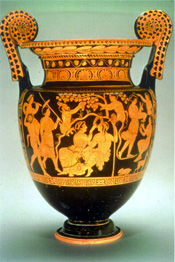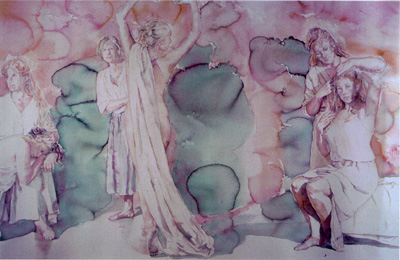

Click here to return to Newsletter contents.
|
The exhibition "The Villa of the Mysteries in Pompeii: Ancient Ritual, Modern Muse," curated by Elaine Gazda, will open October 1, 2000, at the Kelsey Museum and the University of Michigan Museum of Art. The show will center on well-known paintings discovered in 1909 in the Villa of the Mysteries in Pompeii. This ancient fresco cycle depicts statuesque women engaged in activities that have often been connected with the initiation of a young woman into the mysteries of the cult of Dionysus in preparation for marriage.
Read sequentially, this painting cycle displays images of the rituals performed by women interspersed with visual references to the immortal realm mostly populated by mythological males. According to one common interpretation, the women first hear sacred readings and prepare a ritual meal. Then follow glimpses into the world of Dionysus. A mortal woman, who seems to have wandered into this divine realm, appears startled, even frightened, either at the sight of the god himself or by the scenes that follow--the ritual revelation of the phallus and a demon flagellating a young initiate as a maenad dances. Two final scenes, a woman dressing her hair as a bride and a matron looking on, complete the cycle.
|
Painted around 60-40 BC, the cycle decorates what may have been the apartment of the materfamilias, or woman of the house. If the activities depicted on the walls of the room are related to the cult of the Greek god Dionysus (also known as Bacchus, the Roman Liber, and the Etruscan Fufluns), the paintings may indicate that their presumed patroness, the materfamilias, was involved in the cult of that god at Pompeii. It has often been imagined that bacchic rites took place in this room.
Immediately upon its discovery in 1909, the painted cycle was widely publicized as a great masterpiece and quickly became famous. Little more than a decade later, Francis Kelsey, Professor of Latin at the University of Michigan, commissioned a full-scale replica in watercolor by an Italian artist, Maria Barosso, with the intent of making a reconstruction of the whole room in the archaeological museum he hoped to see built at Michigan. Kelsey lived to see Barosso's watercolors on exhibition in 1927 at the Galleria Borghese in Rome, but he died before they could be sent to Michigan. Since their arrival in Ann Arbor, they have been rolled up and stored at the Kelsey Museum. Only two small portions of this replica have ever been exhibited here.
The function and meaning of the Villa of the Mysteries room and its painted decoration have intrigued scholars and lay viewers throughout the twentieth century. The sheer aesthetic power of the wall painting has elicited many artistic responses as well. These are among the facets of the fresco cycle that will be explored in the upcoming exhibition.
A Collaborative Enterprise
Preparation for "The Villa of the Mysteries in Pompeii" has been
a rewarding collaborative experience between the Kelsey Museum and the Museum
of Art. Particular thanks are due to James Steward, Director, and Carole
McNamara, Assistant Director, of the Museum of Art, as well as several graduate
students: Jessica Davis, Elizabeth de Grummond, Catherine Hammer, Brenda
Longfellow, Molly Swetnam-Burland, and Drew Wilburn from the Interdepartmental
Program in Classical Art and Archaeology and Shoshanna Kirk-Jégousse
from the Department of the History of Art, who have worked enthusiatically
on research and other components of the exhibition for the past year and
a half.
The exhibition will also benefit from institutional collaboration, displaying not only the Barosso watercolors and about sixty other objects from the Kelsey collections but also some fifty items borrowed from museums throughout North America: The Metropolitan Museum of Art, Detroit Institute of Arts, Toledo Museum of Art, Rhode Island School of Design Museum of Art, Field Museum of Natural History, Indiana University Museum of Art, Harvard University Art Museums, Seattle Museum of Art, Everson Museum of Art, Mt. Holyoke College Museum of Art, Los Angeles County Museum of Art, and the Royal Ontario Museum. Six contemporary artists will be displaying their work as well.
Women and Cult in Ancient Italy
The Kelsey Museum portion of the installation will explore the ancient social,
religious, and iconographic contexts of the Villa of the Mysteries cycle
in an attempt to throw new light on the possible meanings it may have held
for the women of ancient Campania, especially those of Pompeii. This section
will contain art and artifacts drawn primarily from central and southern
Italy--objects that bear either images of women taking part in rituals or
symbols of the cults that women patronized.
 |
 |
Lucianian Volute Crater by the Creusa Painter, red-figure pottery, 4th century BC. Toledo Museum of Art. Depicts a vineyard with Dionysus and a female companion (possibly Ariadne) in a cave. |
Votive head dedicated by a woman from Campania, terracotta, ca. 3rd century BC. Kelsey Museum 2834. |
Because imagery of the cult of Dionysus/Bacchus/Liber/Fufluns is so prominent in the Villa cycle, material related to that cult will occupy the largest portion of this section. In addition, however, the show includes material drawn from other cults that were popular among women in the region around Pompeii, cults that offered some of the same benefits to women, such as fertility. As this section of the show will demonstrate, much of the imagery of the Villa of the Mysteries cycle was ubiquitous in southern and central Italy.
Also featured in this part of the exhibition will be a reconstructed lararium, or household shrine, which will illustrate how daily religious ritual was conducted in a Roman household in contrast to the "rites" shown in the Villa of the Mysteries cycle. This section of the exhibition will thus prepare visitors for new ideas about how Roman audiences of the mid-first century BC through AD 79, especially women, might have understood the Villa of the Mysteries cycle.
The Watercolor Replica
In the Museum of Art portion of the installation, the majestic, almost full-scale
watercolor replica of the Villa cycle by Maria Barosso will be mounted as
a reconstruction of the room in Villa of the Mysteries where the originals
were found. This replica was exhibited in its entirety only once, in 1927
at the Galleria Borghese in Rome, where it was hailed by Italian critics
and visitors (among whom was the queen of Italy) who found in it and its
Roman counterpart fresh affirmation of their country's ancient glory. Although
Barosso seems not to have been politically active, her work elicited a sympathetic
nationalistic response in early Fascist Italy.
At the entrance to this section of the exhibition information panels, maps, plans, and a QuickTime virtual reality walk-through of the Villa of the Mysteries will orient viewers to the site and the way the ancient visitor would have approached and experienced the mural cycle. The reconstructed room containing Barosso's watercolor replica will provide visitors a vivid personal sense of that experience.
This part of the show will also display color plates of the cycle from Amedeo Maiuri's publication of the Villa excavations. Photographs of the excavations in progress will allow close comparisons between the actual state of preservation of the cycle soon after 1909 and its state as depicted in Barosso's 1920s replica. Recent photographs, taken in 1999, will challenge viewers to consider whether the condition of the cycle has changed since the 1920s or whether Barosso took artistic license in representing damage already present in her day.
Artistic Sources: Original or Copy?
To explore the relation of the Villa cycle to its artistic sources, the
Museum of Art installation will also present Greek, south Italian, Etruscan,
and Roman artifacts--marble and alabaster sculptures, painted vases, bronzes,
wall painting fragments, terracotta figurines, fragments of cameo glass
and Arretine ware--that illustrate styles, motifs, and (in the case of painted
objects) colors and techniques similar to those found in the Villa frieze.
Here the Barosso watercolors will serve as a reference point for viewers
making visual comparisons. Substantial fragments of Roman wall paintings
of the Second, Third, and Fourth Pompeian styles will help visitors appreciate
the differences between the character of a Roman wall surface and that of
Barosso's replica. They will also help to situate the Villa of the Mysteries
painting stylistically and chronologically within the Second Pompeian Style.
The objects in this section of the exhibition will elucidate the rich multicultural matrix of visual sources that the Pompeian artist could have drawn upon in creating the cycle for the Villa room. This repertoire of readily available imagery and the way the composition of the cycle complements the architecture of the room suggest that the individual components and integrated composition of the Villa cycle need not be construed (as many scholars have) as copies after a single now-lost Greek source. Rather, the south Italian and Etruscan objects in the exhibition will help to contextualize the Villa cycle as a monument closely tied to its immediate cultural environment.
In considering the question of copy versus original, the exhibition will endeavor to explain the modern values that have led twentieth-century scholars and other observers of the Villa of the Mysteries frieze to adopt a hellenocentric theory in interpreting its origins and meaning. It will address the assumptions that underlie this theory and demonstrate that a contextual approach, which embeds the cycle firmly in its Pompeian and regional culture, has equal, if not greater, merit.
The issue of copy versus original takes on a different dimension in relation to the ambiguous status of Barosso's watercolor replica as both a "scientific" record of the ancient monument--what Francis Kelsey thought of as an effort at preservation--and a work of art inspired in part by the nationalistic idealism of early Fascist Italy. The enthusiastic reception of the exhibition of Barosso's work at the Galleria Borghese, the first the prestigious Galleria had ever granted a living artist, underscores the fact that these paintings were not regarded by many of Barosso's contemporaries as mere copies. Selections from the correspondence between Barosso and Kelsey highlight the goals of artist and patron and the difficulties encountered in attaining them.
Responses to Ancient Models
Building upon these considerations of copying and creative reuse of older
models, the Museum of Art installation will include several works that are
either modern copies of known ancient prototypes or are of uncertain authenticity.
Such objects will invite viewers to ponder these other forms of response
to antiquities in recent times.
 |
Extending the exploration of artistic copying and creative inspiration along yet another trajectory, a final part of the Museum of Art installation will feature a selection of works by six contemporary artists in response to the Villa cycle. For example, one prominent California artist, Ruth Weisberg, has painted a work called Initiation, a 28-foot scroll with images that repeat the figural groupings of the ancient frieze but portray present-day women enacting a series of contemporary rituals. Such works, which embrace the art of the past as a source of inspiration, memory, and meaning, are only now being recognized for their importance in the world of contemporary art. These artistic responses to the Villa of the Mysteries cycle remind us of the continuing power of this ancient work to challenge us to determine our position in relation to it.
A conference on the exhibition is scheduled for the weekend of October 27-29. Details will follow in the fall issue of the Newsletter.
Elaine Gazda
This exhibition is being generously funded by the Samuel H. Kress Foundation and the following University of Michigan units: the Office of the Vice President for Research; College of Literature, Science, and the Arts; Horace H. Rackham School of Graduate Studies; Institute for Research on Women and Gender; and the Arts of Citizenship Program.
Click here to return to Newsletter contents.
Copyright © 2000 The Kelsey Museum of Archaeology, University of Michigan. All rights reserved.